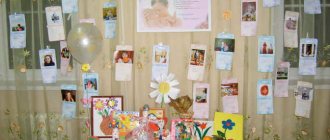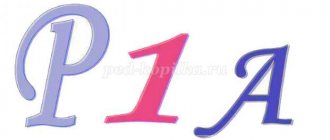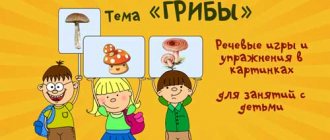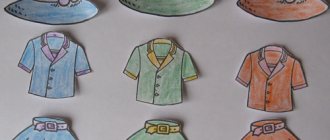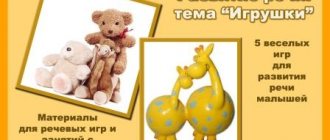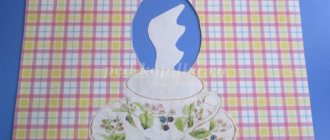MADOOU general developmental kindergarten No. 422 “Lorik”, Yekaterinburg
Parents are recommended:
- talk with your child about what time of year it is, what changes have occurred in living and inanimate nature in the spring;
- remember the names of the spring months, signs of spring;
- observe changes in nature while walking together in the park;
- remember how forest animals and birds behave in the spring, what changes occur in trees and shrubs, meadow and garden plants, in people’s clothing;
- remember the topic “Migratory Birds”;
- tell your child about spring field work.
On the topic children should know:
- the first signs of spring in nature,
- what happened to the snow, how the rivers changed in spring, the length of day and night,
- what trees and grass look like in spring,
- how animals and birds welcome spring,
- what people do in spring, how clothes change,
- know the names of the spring months.
Materials for familiarization with the topic:
Enjoy the beautiful video and beautiful spring music: https://cloud.mail.ru/public/86zK/3fAoNQHfV
We see all the signs of spring in the presentations: https://cloud.mail.ru/public/2FsE/2TkCSzyFS https://cloud.mail.ru/public/3EWE/4ukN8CBmK
Speech development tasks:
- “Pick up a word” : what is the sun like in spring? – warm, radiant, light, bright... What does the sun do in spring? – warms, bakes, caresses, shines, warms...
- Match objects to signs, what happens?
spring – ………., spring – ……….., spring – …………., spring – ……….. Words for reference: day, weather, mood, sun, months, grass, sky, forest, rain, thunderstorm, flowers.
- “Call me kindly”:
Cloud – cloud, ray – …………., ice floe – …………., puddle – ………….., thawed area – ……….., sun – …………..
- Count: one stream, two streams…. Five streams, one shiny icicle, two shiny icicles... five shiny icicles.
- Say it the other way around:
In winter the snow is clean, and in spring…… In winter the days are cold, and in spring……. In winter the sun is dim, and in spring…….. In winter the weather is often cloudy, and in spring…….
- Look at the picture and tell me where the spring rays reached?
- Write a descriptive story about spring using the scheme for describing the seasons.
- Consider a series of plot paintings, think about what comes first and what comes next.
Read the story “The Starlings Have Arrived”: One winter, during a labor lesson, the teacher suggested that the schoolchildren make birdhouses for the starlings. The labor teacher explained to them that this requires tools, boards, nails and patience. The children set to work together. When the birdhouses were ready, the children and their teacher hung them on trees in the park. In the spring, schoolchildren enjoyed watching starlings.
Based on the pictograms (pictures - tips), remember and retell the story.
- Remember the names of migratory birds. Why are these birds called that? Why are they forced to fly away? When do they fly away and return to our region?
LiveInternetLiveInternet
Quote from Tatyana57
Read in full In your quotation book or community!
SPEECH DEVELOPMENT. LEXICAL TOPIC “EARLY SPRING”.
CHILDREN SHOULD KNOW THE NOUNS: spring, March, April, May, snow, icicles, thawed patches, sun, streams, messengers of spring, flood, ice drift, drops, flood, puddles, moisture, crops, planting, awakening, snowdrop, thaw. ADJECTIVES: cold, murmuring, sonorous, talkative, violent, noisy, full of water, spring, radiant, warm, bright, welcoming, red, wet, March, spring waters, azure, clean, clear, bird-like, cool, sunny, loose, harsh . VERBS: has arrived, is advancing, has arrived, has flown out, is circling, curling, fussing, howling, murmuring, running, ringing, flooding, moving, singing, breaking through, melting, shining, warming, warming, dripping, flowing, breathing, smelling, waking up, settle. CHILDREN SHOULD BE ABLE TO SELECT OBJECTS TO ACTIONS: Spring has arrived Swimming - ... Blowing - ... Running - ... SELECT ACTIONS TO OBJECTS: The sun - warms, shines ... Clouds - ... Snow - ... SELECT SIGNS AND VICE VERSE: The earth is black, cold, frozen ... Sun - ... Birds - ... Clean, fast, sonorous - stream Bright, radiant, warm - ... SELECT COMPARISONS: Blue ice looks like (glass ...) Thick fog - ... Fluffy clouds - ... Icicle - ... MAKE SENTENCES WITH THE CONJUNCTION “BECAUSE” : Why does the snow melt? The snow is melting because... Why do streams run?...
Dear parents! Invite your child to answer the questions: What time of year do we spend? (We are saying goodbye to winter.) What time of year begins? (Spring begins.) Introduce your child to the signs of early spring: in the spring nature wakes up; the sun is shining brightly and starting to warm up; The snow melts, streams run, thawed patches appear; icicles appeared on the roofs; the days are getting longer and the nights are getting shorter; the buds on the trees swelled and the leaves hatched; the first grass appeared; snowdrops bloomed; the sparrows chirped cheerfully, the first migratory birds from hot countries will soon arrive; insects woke up; wild animals have risen from hibernation; people took off their warm winter clothes. Read a poem about early spring, memorize it: Drops jump loudly from the roof, Icicles cry above the window. The drops are jumping into my palm, and onto my grandmother’s cat, onto the steps, onto the railing. The cat even opened her mouth. Drops jump loudly from the roof. Spring is coming to us. We hear: Cap! Cap! Cap! Cap! REtelling of the text. MELT WATER. Spring came. The sun is warming. The snow is melting and streams are flowing. There is a lot of water around. Children are happy - they can float boats on the water, splash through puddles in rubber boots. The trees rejoice - they will drink the melt water and will turn green and bloom. The rooks rejoice - there are many worms in the wet soil in the fields. The rooks are full. The sparrows are happy - they drink water, swim in puddles and chirp loudly: “Spring has come!” * ANSWER THE QUESTIONS: - After what time of year does spring come? - What does the sun do? — What happens to the snow? - Who needs melt water? -What are children happy about? — Why do trees need water? - Why are the rooks happy? - Why do rooks need worms? -Who swims in puddles?
SPRING. TEXT FOR RETELLING. Spring is coming. The snow is melting, drops are ringing. In spring the sun shines brightly. The ice is breaking on the river. The buds burst on the trees and fragrant leaves appear. Snowdrops are blooming in the forest. Children hang birdhouses on trees and launch boats. Insects wake up, birds build nests. Spring came! LET'S GUESS RIDDLES ABOUT SPRING: Loose snow melts in the sun, The wind plays in the branches, Birds' voices are louder. So, it has come to us... (Spring) She comes with affection and with her fairy tale. He will wave his magic wand and the snowdrop will bloom in the forest. (Spring) The beauty walks, touches the ground lightly, walks to the field, to the river, and over the snow and over the flower. (Spring) The snowball is melting, the meadow has come to life. The day is coming. When does this happen? (Spring) I open the buds into green leaves. I dress the trees, I water the crops, there is a lot of movement, My name is... (Spring) The snow is turning black in the clearing, The weather is getting warmer every day. Time to put the sled in the closet. What a time of year it is. (Spring) Green-eyed, cheerful, beautiful maiden. She brought us a gift, Something that everyone will like: Greenery for the leaves, Warmth for us, Magic for everything to bloom. Birds flew after her. All the craftswomen sang songs. Can you guess who she is? This girl is... (Spring) Near the snow-covered hummocks, Under a white snow cap, We found a small flower, Half-frozen, barely alive. (Snowdrop) He was the first to emerge from the soil in the thawed patch. He is not afraid of frost, even though he is small. (Snowdrop) In a blue shirt Runs along the bottom of the ravine. (Stream) Not a pedestrian, but walking. People at the gates are getting wet. The janitor catches him in a tub. A very difficult riddle? (Rain) White peas On a green stem. (Lily of the valley) With an inaudible rustle of petals, snow-white pearls blossomed, like a fresh, delicate tiny flower, rushing from under the snow towards the sun. (Snowdrop) Yellow, fluffy, fragrant balls. He will shelter them from the frost in his branches... (Mimosa) He is the Flower Prince-Poet, wearing a yellow hat. An encore sonnet about spring He will read to us... (Narcissus) You will find them in Holland, They are held in high esteem everywhere there. Like bright glasses, they bloom in the parks... (Tulips) A warm southern wind is blowing, the sun is shining brighter. The snow is thinning, softening, melting, the loud rook is flying in. What month? Who will know? (March) The streams are running faster, the sun is shining warmer. Sparrow is happy with the weather The month came to visit us... (March) In warm sunny boots, With a light on the clasps, A boy is running through the snow The snow is scary, the naughty one: As soon as he steps, the snow has melted, The ice on the rivers has broken. He was overcome with excitement. And this boy - ... (March) The river roars furiously And breaks the ice. The starling returned to his house, and the bear woke up in the forest. A lark trills in the sky. Who came to us? (April) The bear crawled out of the den, There was mud and puddles on the road, A lark trilled in the sky. He came to visit us... (April) There was frost at night, There were drops in the morning, So it was outside... (April) The forest, fields and mountains, all meadows and gardens. He knocks on every hole and hums near the water. “Wake up! Wake up! Sing, laugh, smile!” A pipe can be heard far away. This wakes everyone up... (April) The distance of the fields turns green, The nightingale begins to sing. The garden is dressed in white, The bees are the first to fly. Thunder rumbles. Guess what month this is? (May) The garden tried on white, The nightingale sings a sonnet, Our land is dressed in greenery We are greeted with warmth... (May) A baby is running in bast shoes, You can hear his steps. He runs and everything blooms, He laughs and everything sings. I hid happiness in the petals of the lilac bushes. “My lily of the valley, smell sweet!” The cheerful one commanded... (May) Housewarming at the starling's He rejoices endlessly. So that a mockingbird could live with us, We made it... (Birdhouse) Here on a branch is someone’s house. There are no doors or windows in it, But it’s warm for the chicks to live there. This is the name of the house... (Nest) A ball grew on a green fragile leg by the path. The breeze rustled and scattered this ball. (Dandelion) In the midst of Spring, juice drips from the snow-white bark. (Birch) The streams are running faster, the sun is shining warmer, Sparrow is happy about the weather - The month came to visit us... (March). The bear crawled out of the den, Mud and puddles on the road, A lark trilled in the sky - He came to visit us... (April). The garden tried on white, the Nightingale sings a sonnet, our land is dressed in greenery - We are greeted with warmth... (May). The starling's housewarming party - He rejoices endlessly. So that a mockingbird could live with us, we made... (birdhouse). The snowball is melting, the meadow has come to life, the day is coming. When does this happen? (In spring) An ice bag hangs outside the window, It is full of drops and smells of spring. (Icicle) I run to Mother River and cannot remain silent. I am her own son, and I was born in the spring. (Stream) The first to emerge from the ground in a thawed patch. He is not afraid of frost, even though he is small. (Snowdrop) Black, agile, shouts: “Krak!” Worms are the enemy. (Rook) The house was built for the singer. Without windows, without a porch. (Birdhouse) Link to website: https://ejka.ru/blog/zagadki
APRIL. April, April! Drops are ringing in the yard. Streams run through the fields, puddles on the roads. The ants will soon emerge from the winter cold. A bear makes its way through the dead wood. The birds began to sing songs and the snowdrop blossomed.
Quest game on FEMP on the topic “Signs of Spring” in the preparatory group of a preschool educational institution
Quest game on FEMP on the topic “Signs of spring”
Completed by : Olesya Valerievna Sushkova, teacher of MDOBU kindergarten No. 105, Sochi. Relevance : this material will be useful for educators and parents who want to reinforce the signs of spring in a playful way, as well as develop children’s mathematical abilities. Goal : Reinforce with children the characteristic signs of spring through a selection of mathematical games. Objectives: 1. Continue learning to solve addition and subtraction problems; 2. Solve examples within 20 and be able to compare them; 3. Fix ordinal and reverse counting; the ability to name the previous and subsequent numbers; 4. Practice the ability to navigate on a sheet of paper by cells; 5. To cultivate responsiveness and love for nature in children. Attributes: an envelope with a letter and pieces of paper with questions;
a picture of spring, cut into pieces; cards with signs and numbers; diagram – image “Find the bird’s nest”; cards with images of ladybugs with different numbers of dots on their backs; mathematical signs greater than, less than and equal to; ball; checkered sheets and simple pencils according to the number of children. Progress of the lesson
Educator : Guys, look, I found some kind of envelope! Let's see what's inside? (children's answers). (The teacher takes the letter out of the envelope.) — Guys, there’s a letter in the envelope here, let’s read it: “Dear guys! I am Spring Beauty. Winter has bewitched me and won’t let me in! Help me free myself by solving my riddles! Your Spring is beautiful!” Well, guys, let's help our spring? (yes) -Oh, guys, there are still pieces of paper with questions, let's try to answer the questions that are written here? (yes) Task 1. Warm-up - How many seasons of the year; — How many months in a year; - Name the spring months; — How many days are there in a week; - What time of year comes after winter; - Name the times of day. — Well done, you completed the first task. Why do you think spring comes, what is its strength? (children's answers) - That's right, the sun warms us with its rays. In spring, the sun rises higher and more rays hit the ground. That's why spring comes. Here's a part of the picture for you guys. -Guys, you and I need to complete tasks and get parts in order to assemble the picture. Task 2. Put them in order. - Name the signs of spring and put them in order. The numbers shown on the cards will help you with this. (There are cards with numbers and pictures hanging on the board: icicles, streams, ice drift, the first flowers, buds are swelling, leaves are blooming, insects are appearing, birds are flying in. The children need to complete the task by arranging the cards correctly) - Well done guys, you did it. Here is part of the picture. — Next task: Task 3. Solve the example and find the bird’s nest. (diagram showing nests and birds with examples. You need to count and connect the bird and the nest with the same answers) - Well done, you completed the task. Here's another part of the picture. “Now, it’s time to get some rest.” Physical education minute. “Vesnyanka” Sunshine, sunshine (We throw our hands up one by one) Golden bottom! (Swing your torso with your arms above your head) Burn, burn clearly, So that it doesn’t go out! (2 times jumping on two legs) A stream ran in the garden, (Running in place) A hundred rooks flew in, (Flapping their arms like wings) And the snowdrifts melted, melted, (we squat slowly) And the flowers grew! (We spread our palms to the sides in the shape of a flower) - Well done guys! Take your seats. Tell me, what insects wake up in the spring? (children's answers) - That's right, in order for our insects to wake up, we need to compare the numbers on the backs of ladybugs and put the desired sign: greater than, less than or equal to. Task 4. Compare the numbers. (Cards with ladybugs and mathematical signs are displayed on the board. Children complete the task by comparing the number of dots on the backs of ladybugs) - Great! You have completed the task again and earned another part of the picture. - And now, I name the number, and you tell me the previous number and the next one. Task 5. Name the neighbors of the number. (Children catch the ball and name the necessary neighbors of the number). - Great! You've done it all. Here's another part of the picture. - Now let’s try to solve the spring problems. Task 6. Solve the problem . 1. There were 7 birds sitting on a branch. 3 more flew in. How many birds are there? 2. 12 snowdrops grew in the thawed area. 3 snowdrops were picked. How many snowdrops are left in the thawed patch? 3. 15 buds bloomed on the tree in the morning. And in the evening 4 more blossomed. How many buds were there on the tree? - Well done boys. All problems were solved. Here's part of the picture. - Look, we have almost completed the picture. One more piece is missing. To do this, let's take a pencil and do one more task. And we will free our Spring-beauty. Task 7. Graphic dictation. Step back 9 cells on the left, 2 cells on top, put a dot and start drawing.
1 cell right, 1 down, 1 right, 1 down, 1 right, 1 down, 1 right, 1 down, 1 right, 2 down, 1 right, 2 down, 1 right, 2 down, 1 right, 4 down, 1 left, 1 down, 2 left, 1 down, 2 left, 1 down, 2 left, 3 down, 1 left. You and I have a spring leaf. - Well done, guys, you helped spring with your knowledge. And now winter will recede and real spring will come, which will bring us warmth and joy. Look how beautiful and spring-like our picture turned out. Applications
Task No. 2. Put them in order. goal: to consolidate the names of spring signs, the ability to correlate numbers and pictures.
Task No. 3. Solve the example and find a nest for the bird.
Task No. 4. Compare the numbers.
We recommend watching:
Didactic game on mathematics in kindergarten for children 4-6 years old. Geometric figures Do-it-yourself didactic game for preschoolers 4-6 years old according to FEMP Mathematical KVN in kindergarten for older preschoolers Summary of an intellectual game in mathematics for children of the preparatory group of a preschool educational institution
Similar articles:
Mathematical role-playing game for children of the preparatory group
Mathematical fairy tale for children 5-7 years old
Homework for children with special needs on the topic “Spring”
Topic: “Spring. Signs of spring. Animals and plants in spring. Adult labor"
1. What time of year is it? (spring has come). What spring months do you know? Name the current one. (March April May). Tell us what changes in nature have occurred in the spring (signs of spring - the sun shines more often and brighter, the snow is melting, streams are running, thawed patches appear on the ground, drops are ringing, the sky has become blue, white clouds are floating across it, birds are returning from warm countries, animals are waking up from hibernation, change their coats, prepare for the birth of their cubs. Soon the buds will swell on the trees, the first spring flowers will appear on the ground - snowdrops and mother and stepmother, the grass will turn green)
2. Tell us what people do in the spring in the fields, gardens and vegetable gardens. What tools do people use to work in gardens and vegetable gardens? (digging the ground, preparing beds for planting, fertilizing the soil, replanting seedlings, planting flowers and trees, whitening tree trunks to protect them from insects, preparing fields for sowing wheat, etc. tools: shovel, rake, watering can, saw , brush)
3. “Call it affectionately”: garden – garden, vegetable garden – ………, garden bed – ……, apple tree – ……, sun – ……., stream – ………, puddle – ……., tree – ……… ., thawed area – …….. 4. Say the opposite: warm – cold, damp – …… (dry), dirty – ………, cloudy – ………, light – ……., day – …….., morning - ………., rainy - …….
5. Choose as many words as possible: • SPRING – day, rain, thunder, flower, etc. • SPRING – drops, thunderstorm,…………. • SPRING – flowers, days, ……. 6. Correct the sentences: • THE SUN IS SHINING BECAUSE IT HAS GOT WARM. 7. Remember and name who has cub and chick: For a bear - ……….. For a badger - ……….. For a fox - ……………. For a she-wolf - ………….. For a hare - …………… For a hedgehog - ……………. For the starling - ………….. For the magpie - …………… For the rook - ……………..
Topic: “First spring flowers”
1. Listen carefully, repeat from memory: SNOWDROP, DANDELION, MOTHER - AND - STEPMOTHER. Tell me in one word what it is. (Flowers). These flowers appear in the spring, which means they are the FIRST SPRING FLOWERS. Determine the number of syllables in the words: FLOWER, SNOWDROP, DANDELION.
2. Remember and tell what parts a flower has and what they are needed for. (Root, stem, leaves, buds, flowers)
3. Choose 3 words - definitions for these words:
• Dandelion (which one?) – yellow, tall, beautiful • Snowdrop (which one?) – tender, fragrant, …….. • Mother – and – stepmother (which one?) – fragrant, ……………..
4. Answer using the following example:
• 1 snowdrop – 2 snowdrops – 5 snowdrops • 1 dandelion – ……………………………………………………….. • 1 flower – ……………………………………………………… …. • 1 stalk – …………………………………………. • 1 leaf – ……………………………………………………………
5. Listen to the text, answer the questions at the end of the text in complete sentences. Retell the text yourself.
Snowdrops.
Snowdrops bloom along the edges of forests and in sunny meadows in early spring. The snow has not yet melted in the deep ravines. And under the trees they bloom, flowers spread out in a white and blue carpet. These are snowdrops - the first spring flowers of our forest.
• What did you learn from the story about snowdrops? When do they bloom? Where do they grow? What color are they? • What other spring flowers do you know?
The very first, the most subtle There is a flower with the name tender. Like a ringing drop of hello, It’s called...
See KIESOplast97 information on the website.
Topic: “Early spring. Signs of spring, plants and animals in spring"
1. What time of year is it outside? Explain why you think so. Name the first month of spring, the second, the third. What month is it now? What happened before it, what will happen after it?
2. Find the common word: • It pours, murmurs – ……….. • Blows, makes noise – …………… • Warms, shines – …………..
3. Count to 5, correctly coordinating the words: little snowdrop, ringing brook
4. Come up with 3 words - definitions: • Spring (what?) - early, warm, sunny. • Sky in spring - ………………………………. • Weather in spring - ……………………………. • Snow in spring - ……………………………….
5. Remember and name migratory birds. (at least 3). Explain why they are called migratory.
6. Who has whom? For a bear – ………….., for a fox – ….., for a hare – …….., for a badger – …….., for a hedgehog – ……., for a she-wolf – ………….
7. Write your own story about early spring. (5 - 6 sentences)
Author of the material: Kravchuk Irina Anatolyevna
